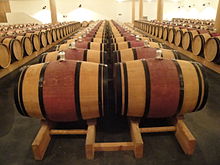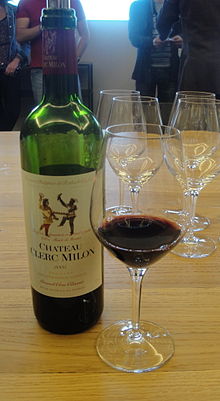Château Clerc-Milon-Rothschild
The Château Clerc Milon is a vineyard of Bordeaux . Since the classification of 1855 the winery has been classified as Cinquième Grand Cru Classé (fifth level of classification).
Since the death of Baron Philippe de Rothschild in 1988, his daughter, Philippine de Rothschild-Sereys , has been running the family business. The day-to-day business is the responsibility of the GFA (Groupement Foncier Agricole) Baronne Philippine de Rothschild. The GFA is part of the Domaines Philippe de Rothschild, which also owns the Premier-Cru-Gut Château Mouton-Rothschild and Château d'Armailhac and which is involved in international projects such as Opus One .
The wine
The estate is located in Pauillac and is of medium size with around 43 hectares . 46% of the area is planted with the Cabernet Sauvignon grape variety , 39% with Merlot , 12% with Cabernet Franc , 2% with Petit Verdot and 1% with Carménère . The average age of the vines is around 40 years and the planting density is almost 8,500 vines per hectare. In the middle years the estate produces around 170,000 bottles of wine . Special mention should be made of all younger vintages from 1995 onwards, which with more than 86 PP are all in the very good to excellent range.
The alcoholic fermentation takes place during 15 to 22 days in temperature-controlled stainless steel tanks. The red wine is then transferred to barriques , where it remains for 16 to 18 months. 30 percent of the barriques are renewed annually.
location
The estate is located in Pauillac in the north, in the immediate vicinity of the vineyards of Château Mouton-Rothschild and Château Lafite-Rothschild .
The vineyards are on a hilltop. The mighty gravel layer of this knoll rests on a limestone plinth. This ballast comes from deposits of the nearby Gironde , which were washed up in fluvoglacial waters over the Garonne from the Pyrenees at the end of the Günz glacial period .
The Cabernet Sauvignon grape variety thrives on this soil. In addition to the fact that the soil is extremely barren and that the yields are therefore naturally reduced, the heat balance of the vineyards, which is favored by the gravel, contributes to the earlier maturity of the grape variety. Due to the massive gravel layer, the vine plant is forced to drive the roots very deep into the ground; the range of nutrients is more diverse and has a minor influence on the variety of aromas in the wine.
history
The name of the estate refers to the nearby hamlet of Milon (the same applies to the Château Duhart-Milon-Rothschild estate ) and to the first known owner, Jean-Baptiste Clerc. Clerc was verifiably the owner when the estate was confirmed at the world exhibition in 1855 in the rank of 5th plant. Shortly before his death in 1863, he sold part of the property, which came into the possession of the notary Jacques Mondon. Mondon managed to claim the right to the name of the estate and had the name changed to Clerc-Milon-Mondon .
When Jacques Mondon died in 1897, his widow Angèle managed the estate until 1940. Via their daughter Germaine (married Vialard), the estate finally passed to Germaines daughters Marie and Antoinette. After Mondon's death the estate suffered a series of serious crises. In addition to the phylloxera disaster and the first appearance of powdery mildew , the two world wars and the global economic crisis sapped the substance of the property.
Marie Vialard and Antoinette's husband Louis Hedon inherited a run-down winery, which they sold in 1970 for one million francs to Philippe de Rothschild, the owner of Mouton. Between 1947 and 1969 the wines were sold exclusively through the Dourthe trading house.
literature
- Charles Cocks, Edouard Féret, Bruno Boidron: Bordeaux et ses vins . 18th edition. Èdition Féret et Fils, Bordeaux 2007, ISBN 978-2-35156-013-6 .
- Horst Dippel : The wine lexicon . 3. Edition. Fischer Taschenbuch Verlag, Frankfurt am Main 1999, ISBN 3-596-13826-4 .
- Robert Parker : Parker's Wine Guide (= Collection Rolf Heyne ). Heyne, Munich 2000, ISBN 3-453-16305-2 .
Web links
- bpdr.com Website of the Domaines Philippe de Rothschild group.
- Medoc-wines.com website (German)


